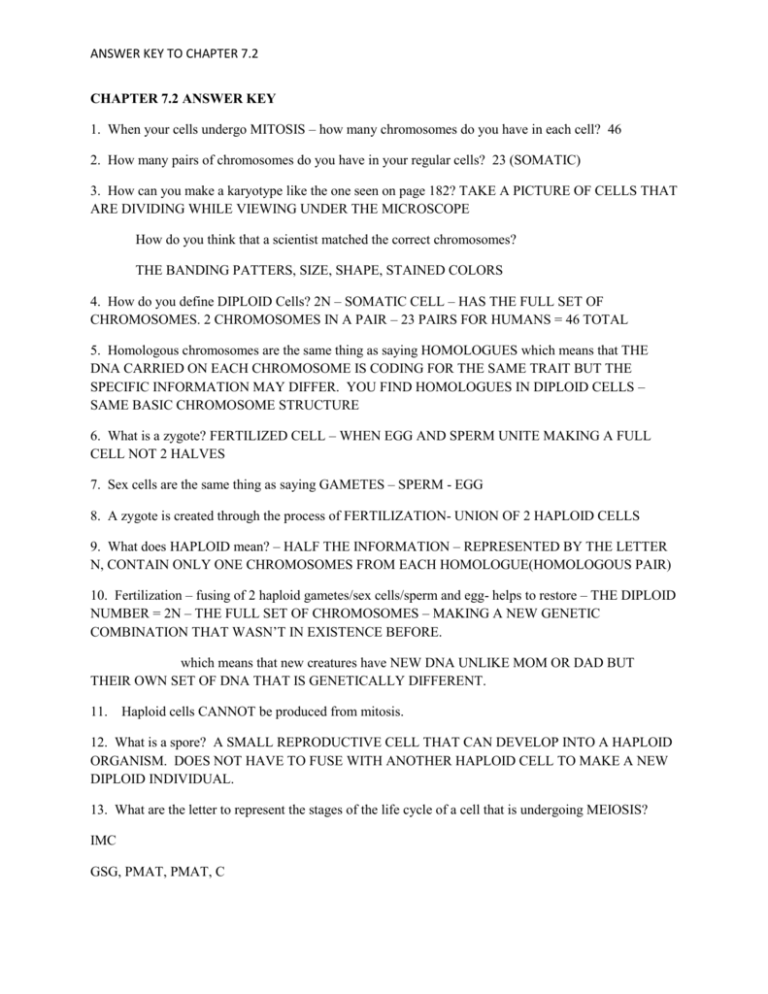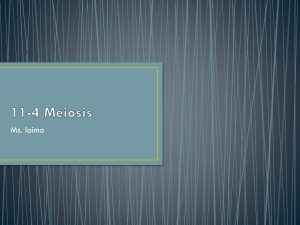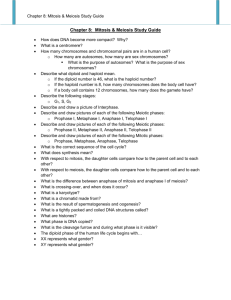CHAPTER 7.2 Worksheet on Feb 12 ANSWER KEY
advertisement

ANSWER KEY TO CHAPTER 7.2 CHAPTER 7.2 ANSWER KEY 1. When your cells undergo MITOSIS – how many chromosomes do you have in each cell? 46 2. How many pairs of chromosomes do you have in your regular cells? 23 (SOMATIC) 3. How can you make a karyotype like the one seen on page 182? TAKE A PICTURE OF CELLS THAT ARE DIVIDING WHILE VIEWING UNDER THE MICROSCOPE How do you think that a scientist matched the correct chromosomes? THE BANDING PATTERS, SIZE, SHAPE, STAINED COLORS 4. How do you define DIPLOID Cells? 2N – SOMATIC CELL – HAS THE FULL SET OF CHROMOSOMES. 2 CHROMOSOMES IN A PAIR – 23 PAIRS FOR HUMANS = 46 TOTAL 5. Homologous chromosomes are the same thing as saying HOMOLOGUES which means that THE DNA CARRIED ON EACH CHROMOSOME IS CODING FOR THE SAME TRAIT BUT THE SPECIFIC INFORMATION MAY DIFFER. YOU FIND HOMOLOGUES IN DIPLOID CELLS – SAME BASIC CHROMOSOME STRUCTURE 6. What is a zygote? FERTILIZED CELL – WHEN EGG AND SPERM UNITE MAKING A FULL CELL NOT 2 HALVES 7. Sex cells are the same thing as saying GAMETES – SPERM - EGG 8. A zygote is created through the process of FERTILIZATION- UNION OF 2 HAPLOID CELLS 9. What does HAPLOID mean? – HALF THE INFORMATION – REPRESENTED BY THE LETTER N, CONTAIN ONLY ONE CHROMOSOMES FROM EACH HOMOLOGUE(HOMOLOGOUS PAIR) 10. Fertilization – fusing of 2 haploid gametes/sex cells/sperm and egg- helps to restore – THE DIPLOID NUMBER = 2N – THE FULL SET OF CHROMOSOMES – MAKING A NEW GENETIC COMBINATION THAT WASN’T IN EXISTENCE BEFORE. which means that new creatures have NEW DNA UNLIKE MOM OR DAD BUT THEIR OWN SET OF DNA THAT IS GENETICALLY DIFFERENT. 11. Haploid cells CANNOT be produced from mitosis. 12. What is a spore? A SMALL REPRODUCTIVE CELL THAT CAN DEVELOP INTO A HAPLOID ORGANISM. DOES NOT HAVE TO FUSE WITH ANOTHER HAPLOID CELL TO MAKE A NEW DIPLOID INDIVIDUAL. 13. What are the letter to represent the stages of the life cycle of a cell that is undergoing MEIOSIS? IMC GSG, PMAT, PMAT, C ANSWER KEY TO CHAPTER 7.2 14. What makes the process of MEIOSIS in MALES different from FEMALES? MALES MAKE 4 HAPLOID SPERM FROM ONE DIPLOID CELL. THE SPERM HAVE ½ THE DNA AS THE PARENT CELL. THE CENTRIOLES WILL FORM INTO A FLAGELLUM TO MAKE THE SPERM “SWIM”. 15. If MEIOSIS did NOT occur…THE LIFE CYCLE OF MANY ORGANISMS COULD NOT CONTINUE. NO SPERM OR EGG SO NO FERTILIZATION… 16. With only MITOSIS as a form of reproduction there is very little variation. Since cloning is the goal of mitosis, the only way that any “change” occurs is due to…MUTATION - ERRORS 17. How is VARIATION important to a species (made possible through MEIOSIS)? MAKES ALL DIFFERENT KINDS OF TRAITS/CHARACTERISTICS ALLOWING FOR A BETTER CHANCE AT SURVIVAL IF THE ENVIRONMENT WOULD CHANGE OVER TIME. 18. How does MEIOSIS increase variety? HALF + HALF GIVES YOU A NEW ORGANISM UNLIKE ANY OTHER KIND OF ORGANISM. GENETIC RECOMBINATION! COMPLETE THE SECTION REVIEW ON PAGE 190 #1-5 1. REPRODUCTIVE CELLS, FORMED BY MEIOSIS, WOULD CONTAIN 10 CHROMOSOMES. The 10 chromosomes in the reproductive cells would consist of one member of each homologous pair of chromosomes present in the nonreproductive cells 2. These combinations are a function of how homologous pairs of chromosomes line up during metaphase 1 3. The light fur might camouflage those animals from predators if the environment became colder and have more snow coverage 4. Homologous pairs of replicated chromosomes move together during prophase 1 and form tetrads. During metaphase 1, the tetrads attach to the spindles and line up in the middle. In anaphase 1, one homologue of each pair is pulled toward the pole = away/aside/apart. The centromeres DO NOT split. Each chromosomes in teleophase I is DOUBLE stranded. 5. Critically important!!! Prophase and Anaphase. Why? Prophase = when the homologous chromosomes match up! Anaphase = homologous chromosomes separate. The different combinations of chromosomes is made possible by HOW the chromosomes line up during metaphase and are pulled apart later…







